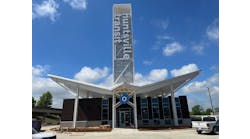The 2008 Rail Safety Improvement Act requires that new positive train control (PTC) collision avoidance systems be deployed by railroad operators by the end of 2015, on all main lines used to transport passengers or materials that are hazardous through inhalation. Existing safety systems use spaced, track-side equipment to determine train location within a block of track, and a relatively simplistic colored-light notification system for drivers. PTC introduces continuous GPS-based location and speed tracking, with more sophisticated onboard wireless technology for enforcing movement authority from a centralized control center, wherever the vehicle may be. PTC will be inherently more reliable, and offer greater real-time functionality than conventional systems, and would prevent accidents such as the 2008 Chatsworth collision where a more advanced control system would have stopped the train automatically and lives saved. Copyright ©2009 STI-CO From PTC Whitepaper, used with kind permission. While the safety benefits of PTC are clear, rail operators cite concerns over timing, spectrum, radio equipment and overall cost - the latter expected to exceed $13 billion for installation and ongoing maintenance over the next 20 years. PTC legislation affects more than 70,000 miles of track and 17,000 locomotives, yet according to the Association of American Railroads (AAR), PTC implementation will yield just $1 of benefits for every $20 spent on it. AAR CEO Ed Hamberger does not mince words when it comes to PTC, stating last week that it was “a bad mandate,” but one that the U.S. Class 1 railroads were going “to live up to” by committing $12 billion in capital expenditures in 2011 alone. Nevertheless the AAR argues that while PTC may make trains safer, Federal Railroad Administration (FRA) claims of commercial benefits - such as cost reductions through increased rail line capacity and network velocity - are flawed. A 2010 study by Oliver Wyman on behalf of the AAR concluded that PTC offers minimal advantage over existing computer-aided dispatch (CAD) systems, for example, and contrary to FRA analysis provides no improvement to fuel economy, track maintenance or locomotive reliability. The AAR contends that safety enhancements using alternative technologies already underway by the rail industry would cost less and be equally effective, while freeing up much-needed budget for other environmental, infrastructure and service improvements. The FRA counters that while individual rail operators including Amtrak, BNSF and CSX had run various safety control schemes over the last two decades, by 2008 the railroad industry as a whole had failed to come up with a network-wide solution. Then Chatsworth happened, prompting the Rail Safety Improvement Act that made PTC a statutory requirement. Despite their differences over the business model, negotiation between the AAR and the FRA has resulted in hundreds of millions of dollars being shaved off roll-out costs due to an agreed reduction in the number of route miles of track that must support PTC, based on revised future projections of hazardous material and passenger transportation. Meanwhile, the Department of Transportation is recommending that railroads not treat PTC as an ‘overlay’ on existing control systems, which would increase operating costs through duplication of infrastructure and maintenance costs. Instead, railroads should replace control systems “bringing PTC closer to cost neutrality” as outlined by the DOT’s Randolph Resor at the PTC World Congress in Miami in February. In the meantime four Class 1 railroads (BNSF, CSX, Union Pacific and Norfolk Southern) have created an Interoperable Train Control Committee (ITC) to establish and develop PTC interoperability standards. The ITC will also work on hardware platforms for wayside, locomotive and base station technology, with a guide to installation best practices being developed by the American Railway Engineering and Maintenance-of-Way Association (AREMA) Committee 39 . The need for a clear-cut systems approach to PTC implementation cannot be exaggerated; this is well illustrated by Amtrak’s ACSES Project in the Northeastern Corridor. Originally built in three phases between 2000 and 2004, the project equipped six hundred trains and four hundred miles of track miles with next-generation safety communications systems. In order to meet the 2015 PTC deadline, Amtrak and integrator partner Alstom must expand PTC coverage to 1,600 track miles by 2012 and 4,600 miles by 2015, the latter stage requiring interoperability with four additional network operators and no less than eight commuter trail agencies. One can see where the money goes. At last year’s Vancouver APTA conference Gerald Hanas, chair of APTA’s Commuter Rail Committee, called for a phased approach to PTC roll-out as quite simply “the financial capacity for PTC may not be there” among regional commuter railroads. New York’s MTA Metro-North estimated its costs for PTC implementation would exceed $350 million, with neighboring Long Island Railroad (LIRR) costing a further $424 million. At the time MTA Metro-North President Howard Permut made clear that without significant new federal aid, funding PTC would divert money from other key infrastructure projects. He also expressed worry over the availability of sufficient radio spectrum and compliant equipment within such a tight timeline, concerns shared by many other transport industry leaders. Despite the financial and technological challenges, agencies are moving ahead with PTC plans to meet the schedule. Last October, Parsons won a $120 million contract with the Southern California Regional Rail Authority (SCRRA) to deploy a PTC solution on the 512-mile Metrolink rail system, which will be interoperable with safety systems used by BNSF. Metrolink aims by 2012 to be the first railroad in the U.S. to fully deploy PTC, utilizing 220MHz spectrum, technology and infrastructure from a wide range of vendors including ARINC, Wabtec, Metercomm and Tower West Communications. Around 80 percent of the total cost of the project will be met by California state fund bonds, with a further $20m from the FRA and $18 million from the U.S. DOT Metrolink, the scene of the Chatsworth disaster, may well be the poster child for PTC implementation and act as an example of best practice for next-generation wireless safety systems on commuter rail. -- Jim Baker is CEO at Xentrans Inc., a wireless project management consultancy based in San Francisco and London. A C-level wireless industry veteran, Baker has been involved in many deployments of wireless technologies on passenger transportation worldwide and is a recognized industry expert on Wi-Fi, 3G and 4G convergence. He is chair of the Technology Committee at the Joint Council on Transit Wireless Communications that is developing a strategic plan for implementation of wireless technologies in mass transit. Contact Baker via LinkedIn or follow him on Twitter.


